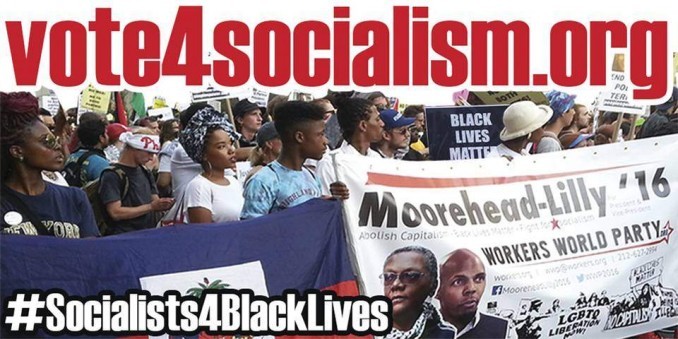Fight Trump’s racism, Clinton’s militarism
 People in other countries are probably scratching their heads, wondering what is going on with politics in the United States.
People in other countries are probably scratching their heads, wondering what is going on with politics in the United States.
A bare six months ago, it looked possible that a self-proclaimed socialist could win the Democratic nomination, something unheard of in U.S. history.
Now there are dire warnings that an erratic, boastful, racist, misogynist, anti-immigrant billionaire could be elected president and drag everything to the right.
Capturing headlines at the moment is the dismay of Democratic Party leaders that many of the politically active young people who have been involved in struggles like the Fight for $15 movement, Black Lives Matter, immigrant rights, the environmental movement, the Bernie Sanders campaign, the LGBTQ movement and even the women’s movement might not vote for Hillary Clinton.
Politicians and liberal establishment voices like the New York Times are conducting a no-holds-barred roundup to drive these potential Democratic voters into the fold. They are bemoaning the fact that when Sanders stumps for Clinton now, he attracts about one-tenth of the crowds he used to.
Their argument, of course, is that if these young progressives don’t vote for Clinton, they could be held responsible for Trump winning the presidency.
Two-party system works — for the rich
For more than two centuries, the two-party political system devised by the early slave owners, bankers and industrialists to run this country has been highly effective in maintaining the rule of the wealthy few, while roping in the support or at least acceptance of the many.
In its early days the system served the interests of the Northern industrialists and bankers at the same time as the Southern plantation owners — until the two systems collided in a great Civil War.
But having resolved the issue of slave owner versus capitalist, chattel slavery versus wage slavery, the two parties revived their collaboration in the interests of profit with the betrayal of Black Freedom in 1876-77, ending the short-lived Reconstruction era.
The two-party system survived the challenge of the Populist movement toward the end of the 19th century, as well as the great labor struggles of the Depression. All along, both parties have held imperialist wars sacrosanct, making sure that the military-banking-industrial complex comes first, even in times of severe budget crises.
So what about the current quadrennial election? What’s new about this one? As ever, it mainly features a Democrat versus a Republican, although the candidates do provide a more striking contrast than in earlier presidential contests.
Moving left or moving right?
As the capitalist stagnation that has devastated so many areas drags on, the resulting widespread suffering is undermining the political status quo.
But the question is: Are the workers in the U.S. moving to the left or to the right? Is Trump appealing to a new right-wing movement? Or is his campaign picking up most of its votes from those who are not in motion, not organized, but seem to idolize a media superstar who promises he’ll fix it all, just vote for him?
By constantly calling Trump supporters “white workers,” the corporate media can make it seem there is a reactionary shift going on in the working class. But when have they ever described the many progressive social movements in this country in similar class terms?
For quite a few years, many, many people have been marching, reaching out through social media, getting together flash mobs and other inventive forms of protest. They are largely young and very outspoken, breaking all kinds of repressive barriers. They have stood up to cops and security guards. And the vast majority of them are working class.
Dynamic people of color have been in the leadership of many of these movements, and there are also many, many white workers — with or without jobs — who passionately hate the system and all the forms of bigotry that divide our class.
Streets belong to the people
The streets belong to the people — it’s not just a slogan. The reactionaries, the bigots, are not in the streets. Except for a tiny hardcore, they have been hesitant to air their backward, hateful ideas for public scrutiny and criticism. But Trump and reactionary media moguls have given them a loud platform.
Since Sanders gave in and endorsed Clinton, the movement that had looked to him for a new course has had to rethink what to do next. They’re not going for Trump, obviously. But they can’t have much confidence in Clinton and the Democratic establishment, either.
They know that, after eight years of a Democratic administration, even one headed for the very first time by an African-American president, little has changed in the racist, anti-worker, pro-corporate workings of the U.S. government.
The jails are still stuffed with the poor. Cops still shoot down unarmed Black people, even children.
The super-rich suck up an ever larger portion of the wealth, while cities like Flint, Detroit, Oakland, Chicago, Baltimore and Cleveland and many rural areas suffer unbearable levels of unemployment, homelessness and decay.
The Pentagon-banking-industrial complex continues to apply its expertise in killing people across the globe — and in seizing trillions in tax dollars from the public treasury in Washington.
The global environmental crisis continues to take a back seat to the profits of the oil and chemical companies and Wall Street portfolios.
Whichever capitalist candidate gets more votes in this election, it won’t change all this — or eliminate the progressive movements in this country.
What is crucial is that the movements stay independent of the capitalist establishment and true to their origins, have confidence in their own strength, and not become an appendage to the “less reactionary” of the two imperialist parties.

